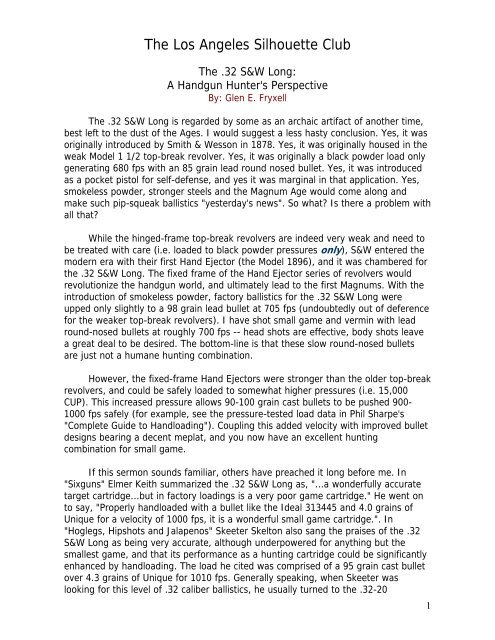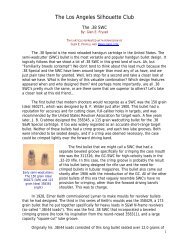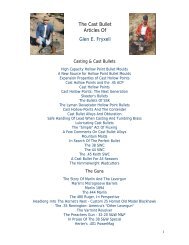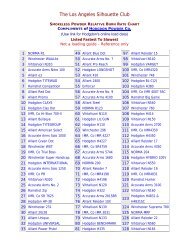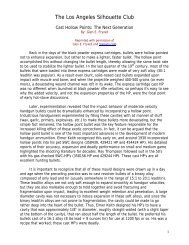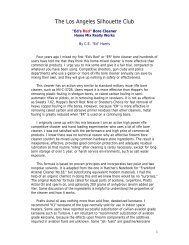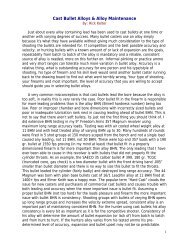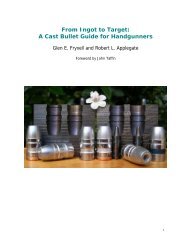The Los Angeles Silhouette Club - LASC Front Page
The Los Angeles Silhouette Club - LASC Front Page
The Los Angeles Silhouette Club - LASC Front Page
You also want an ePaper? Increase the reach of your titles
YUMPU automatically turns print PDFs into web optimized ePapers that Google loves.
<strong>The</strong> <strong>Los</strong> <strong>Angeles</strong> <strong>Silhouette</strong> <strong>Club</strong><br />
<strong>The</strong> .32 S&W Long:<br />
A Handgun Hunter's Perspective<br />
By: Glen E. Fryxell<br />
<strong>The</strong> .32 S&W Long is regarded by some as an archaic artifact of another time,<br />
best left to the dust of the Ages. I would suggest a less hasty conclusion. Yes, it was<br />
originally introduced by Smith & Wesson in 1878. Yes, it was originally housed in the<br />
weak Model 1 1/2 top-break revolver. Yes, it was originally a black powder load only<br />
generating 680 fps with an 85 grain lead round nosed bullet. Yes, it was introduced<br />
as a pocket pistol for self-defense, and yes it was marginal in that application. Yes,<br />
smokeless powder, stronger steels and the Magnum Age would come along and<br />
make such pip-squeak ballistics "yesterday's news". So what Is there a problem with<br />
all that<br />
While the hinged-frame top-break revolvers are indeed very weak and need to<br />
be treated with care (i.e. loaded to black powder pressures only), S&W entered the<br />
modern era with their first Hand Ejector (the Model 1896), and it was chambered for<br />
the .32 S&W Long. <strong>The</strong> fixed frame of the Hand Ejector series of revolvers would<br />
revolutionize the handgun world, and ultimately lead to the first Magnums. With the<br />
introduction of smokeless powder, factory ballistics for the .32 S&W Long were<br />
upped only slightly to a 98 grain lead bullet at 705 fps (undoubtedly out of deference<br />
for the weaker top-break revolvers). I have shot small game and vermin with lead<br />
round-nosed bullets at roughly 700 fps -- head shots are effective, body shots leave<br />
a great deal to be desired. <strong>The</strong> bottom-line is that these slow round-nosed bullets<br />
are just not a humane hunting combination.<br />
However, the fixed-frame Hand Ejectors were stronger than the older top-break<br />
revolvers, and could be safely loaded to somewhat higher pressures (i.e. 15,000<br />
CUP). This increased pressure allows 90-100 grain cast bullets to be pushed 900-<br />
1000 fps safely (for example, see the pressure-tested load data in Phil Sharpe's<br />
"Complete Guide to Handloading"). Coupling this added velocity with improved bullet<br />
designs bearing a decent meplat, and you now have an excellent hunting<br />
combination for small game.<br />
If this sermon sounds familiar, others have preached it long before me. In<br />
"Sixguns" Elmer Keith summarized the .32 S&W Long as, "...a wonderfully accurate<br />
target cartridge...but in factory loadings is a very poor game cartridge." He went on<br />
to say, "Properly handloaded with a bullet like the Ideal 313445 and 4.0 grains of<br />
Unique for a velocity of 1000 fps, it is a wonderful small game cartridge.". In<br />
"Hoglegs, Hipshots and Jalapenos" Skeeter Skelton also sang the praises of the .32<br />
S&W Long as being very accurate, although underpowered for anything but the<br />
smallest game, and that its performance as a hunting cartridge could be significantly<br />
enhanced by handloading. <strong>The</strong> load he cited was comprised of a 95 grain cast bullet<br />
over 4.3 grains of Unique for 1010 fps. Generally speaking, when Skeeter was<br />
looking for this level of .32 caliber ballistics, he usually turned to the .32-20<br />
1
cartridge, but I suspect that was in large part due to the fact that the .32-20 was<br />
available in his beloved Colt Single Action Army, while the .32 S&W Long was not.<br />
Several other gun writers have gone on record in favor of the .32 rimfire rifle as<br />
a preferred small game load. For those of you that might not be familiar with the<br />
ballistics of the old black powder .32 rimfire loads, they generally had an 80-90 grain<br />
lead bullet at 950-1050 fps. <strong>The</strong> .32 rim fires had a reputation for adequate accuracy<br />
out to about 50 yards (black powder fouling could be problematic), and would kill<br />
small game cleanly without spoiling a lot of meat. When .32 rimfire ammo became<br />
scarce and hard to find, many of these shooters moved on to reproduce these<br />
ballistics in a .32-20 rifle or revolver, but the extra case capacity isn't necessary to<br />
achieve this ballistic level and a solid-framed .32 S&W Long revolver is just as<br />
capable of reproducing the old .32 rimfire ballistics (and accurate loads will probably<br />
be easier to find than with the .32-20). This, I would argue, is the special niche that<br />
the .32 S&W Long now occupies -- the ~95 grain bullet at 900-1000 fps, useful for<br />
hunting small game.<br />
Yes, we now have stronger steels and modern CNC machine capabilities, and<br />
we can build better, stronger, more powerful revolvers than ever before. Yes, we<br />
now have the .32 H&R Magnum and the .327 Federal, both capable of delivering<br />
significantly higher velocities than the ancient .32 S&W Long. So what For the<br />
small-game hunter the bottom-line is that a rabbit is still a rabbit, and a squirrel is<br />
still a squirrel. I really like Brunswick stew, and I'm not a big fan of a whole lot of<br />
bloodshot goo. <strong>The</strong> .32 S&W Long kills small game cleanly (it is significantly more<br />
effective that the .22 Long Rifle), and doesn't spoil a lot of meat in the process. <strong>The</strong><br />
.32 H&R Magnum and .327 Federal are both fine varmint cartridges, but their extra<br />
velocity equates to a certain amount of wasted meat when the quarry is intended for<br />
the dinner table. I have (and hunt with) more powerful handguns, but when edible<br />
small game is on the menu there is a strong probability that a .32 S&W Long revolver<br />
will be along for the ride. Simply stated, when properly loaded, the .32 S&W Long is<br />
the perfect small game cartridge.<br />
Handloading the .32 S&W Long:<br />
<strong>The</strong> .32 S&W Long is pretty much a definitive "small case" in terms of powder<br />
capacity. Uniform ignition is not a problem since the brisance of pretty much any<br />
primer will completely fill the available volume in the loaded round. <strong>The</strong> small case<br />
capacity, combined with the pressure limitations, make the .32 S&W Long best<br />
served by the medium to fast burning pistol powders, ranging from Bullseye on the<br />
fast side out to about HS-6 on the slow side. I have gotten excellent results with Red<br />
Dot and W231 in the .32 S&W Long. Red Dot in particular, bulks up well in the tiny<br />
case and has given me excellent accuracy over the years in the .32 S&W Long.<br />
Bullseye, PB and American Select are also excellent choices for the .32 S&W Long. A<br />
pound of powder goes a LONG ways when it's metered out in 2.0 to 2.5 grain doses!<br />
One of the things that appeals to me about the .32 S&W Long is how well it<br />
performs with cast bullets. In fact, in all of the thousands and thousands of rounds of<br />
.32 S&W Long that I've shot over the years, fewer than 1% of them have involved<br />
2
jacketed bullets. At ~900 fps and 15,000 CUP, cast bullets are right at home, and<br />
just make sense. With a gang mould and a pot full of lead, you can make bunch of<br />
.32 cast bullets in a hurry from a few pounds of scrap wheel weights! As far as<br />
mould designs go, there are some excellent .32 wadcutter moulds available from<br />
RCBS, NEI (I like #79 in PB form) and H&G (originally listed as #66 by H&G, now<br />
available from Ballisti-Cast), and at one time Lyman made a couple of very<br />
interesting variations on the .32 wadcutter theme that make for very interesting field<br />
loads (the 95 grain 313445 SWC and the 93 grain 313492 Type III wadcutter). Other<br />
.32 cast bullet designs worthy of note are the timeless Lyman/Ideal 3118 (now<br />
labeled the 311008), the RCBS 98 grain SWC, the RCBS 88 grain Cowboy bullet, and<br />
SAECO also makes some good-lookin' .32 moulds (I have an old Cramer 95 grain<br />
SWC that I am very fond of, a design that SAECO still offers). Several years ago, I<br />
had Mountain Molds make a mould for me to produce a 98 grain .312" Keith-style<br />
SWC (73% meplat, three equal driving bands, beveled crimp groove and a big flat<br />
grease groove). A couple of years later, this bullet was used as inspiration for one<br />
the Lee custom mould Group Buys for a 6-cavity gang mould to make a .315"<br />
diameter 98 grain Keith-style SWC (there were some changes made to the ogive and<br />
driving bands). <strong>The</strong> bottom-line is that there is no shortage of good bullet moulds<br />
available to the handgun hunter who wants to hunt with the .32 S&W Long.<br />
Some of the excellent cast bullet designs available for<br />
the .32 S&W Long (l-r: H&G #66, NEI #75, RCBS .32-<br />
90-Cowboy mould, Cramer #52D 95 grain SWC (now<br />
available as the SAECO #325), Lee custom Group Buy<br />
98 grain Keith-style SWC, Mountain Molds Keith-style 98<br />
grain SWC, Ideal 31133 (the 109 grain HP version of the<br />
3118), and the 115 grain Lyman 311008).<br />
My preferred load for the<br />
Type I wadcutters (i.e. the buttonnosed<br />
target bullets that are<br />
seated deeply) is 2.0 grains of<br />
Bullseye (which, conveniently, is<br />
the lightest load I can get my<br />
Dillon 550B powder measure to<br />
drop), which averages about 750<br />
fps or so (depending on barrel<br />
length), and with that full-diameter meplat it anchors grouse very effectively. For the<br />
lighter field bullets (like the RCBS cowboy bullet and the Lyman 313492, both of<br />
which weigh about 90 grains when they drop from my moulds), I like to load them<br />
on top of 2.6 grains of Red Dot for about 965 fps, a load that delivers excellent<br />
accuracy. Both of these loads drop small game effectively, and don't waste a lot of<br />
meat in the process. For the 98-100 grain SWC bullets, like the RCBS 98 grain SWC<br />
and Keith-style SWC’s, I have gotten very good results with a variety of powders<br />
(from Red Dot to HS-6), but commonly turn to 2.5 grains of Red Dot or 3.0 grains of<br />
W231, both of which produce a little over 900 fps (depending on barrel length) and<br />
excellent accuracy.<br />
Another thing that I like about the .32 S&W Long is that the brass seems to last<br />
forever. I can't recall ever having a case wear out, or split.<br />
<strong>The</strong> guns:<br />
That brings us to the guns -- ah yes, the guns! As mentioned earlier, the .32<br />
S&W Long was originally brought out in the weak, top-break S&W Model 1 1/2. I am<br />
going to skip over the old black powder hinged-frame guns since the focus of this<br />
3
article is on the optimum small game hunting<br />
loads, generally operating in the 900-1000 fps<br />
range, and these loads are entirely unsuitable<br />
for the old top-break guns. That brings us to the<br />
Hand Ejectors -- as this is written, I have no<br />
first-hand experience with the Model 1896 (I<br />
hope to change that in the near future), but I<br />
have plenty of experience with the Model 1903<br />
(and the various changes associated with that<br />
Model). This dainty little I-framed sixgun is just<br />
about the definitive "grouse gun" in my mind --<br />
light, easily carried in a vest pocket or bib<br />
.32 S&W Long ammo, loaded with a few<br />
of the excellent cast bullet designs<br />
available (l-r: NEI #75 wadcutter, RCBS<br />
.32-90-Cowboy bullet, Lyman 313445,<br />
Lee custom Group Buy 98 grain Keithstyle<br />
SWC, Mountain Molds Keith-style<br />
98 grain SWC, RCBS 98 grain SWC, and<br />
the Ideal 31133 HP).<br />
overalls when hunting big game, and able to dispatch a grouse quickly and cleanly<br />
without wasting a lot of meat (and without making a lot of noise). <strong>The</strong> Model 1903<br />
was available with 3 1/4", 4 1/4" and 6" barrels. I have shot all three, and they have<br />
all shot very well for me. <strong>The</strong> one issue that I've encountered is that the sights are<br />
rather fine, and with bifocals sometimes it can be a challenge to quickly get a good,<br />
clean sight picture. But these little I-frames sure do shoot! <strong>The</strong> 3 1/4" I have has a<br />
bore that still has decent land/grooves, but is spider-webbed with pitting throughout<br />
the length of the barrel -- and it will still put 12 shots into 1 1/4" at 50 feet! <strong>The</strong><br />
other I-frame .32 S&W Longs I've shot have displayed similar capabilities. I ran some<br />
tests on 4 different I-frame .32 S&W Long revolvers -- all 4 guns would allow a<br />
Hornady 85 grain XTP (that mikes .312" on the nose) to pass smoothly (the 3 1/4"<br />
Model 1903 was a little snug, but it still passed), and none would allow a cast bullet<br />
sized .313" to pass. Clearly, a good place to start with cast bullets for these little<br />
guns is .312".<br />
<strong>The</strong> I-frame .32 S&W Long (Model 1903) was<br />
available with 3 1/4", 4 1/4" and 6" barrels.<br />
S&W built the I-frame (and the<br />
improved I-frame) up until 1961, when they<br />
introduced the J-frame. By this point, the<br />
revolver was known as the Model 30 (round<br />
butt) or Model 31 (square butt). Years ago,<br />
I picked up a 3" Model 31, and it not only<br />
shoots to the fixed sights, it groups quite<br />
nicely to boot! I haven't carried this little J-<br />
frame very often because it's just too pretty<br />
to get beat up when I'm in the black timber<br />
hunting elk, but it has nonetheless<br />
accounted for a handful of vermin and small<br />
game in the off-season. Throats on this revolver run<br />
just a little over .313", so that's what I size cast bullets<br />
when I'm loading for it.<br />
S&W also built a few .32 S&W Longs on the K- <strong>The</strong> J-frame .32 S&W Long<br />
frame. <strong>The</strong>se tend to be rather rare, and you don't run (Model 31-1), with a 3"<br />
barrel and fixed sights.<br />
across them every day. I was fortunate to pick up a 4"<br />
M&P in .32 S&W Long a while back, and it has quickly turned into one of my personal<br />
4
favorite revolvers. <strong>The</strong> bluing on the barrel is worn, but mechanically this gun is in<br />
very good shape, and it is one fine shooter! In this revolver, cast bullets sized .313"<br />
are a snug fit in the throats, and so that is how I size them.<br />
S&W made a few M&Ps (K-frame) chambered<br />
for .32 S&W Long.<br />
I have always wanted a K-32 Target<br />
Masterpiece, but given the steep prices they<br />
tend to command, I just haven't been able<br />
to find one that I could afford. So a number<br />
of years ago I decided to have a custom<br />
gun built instead (and still ended up saving<br />
a bunch of money). I bought a 6" fulllugged<br />
Model 16 barrel (from the .32 H&R<br />
Magnum production run) and a K-22 cylinder, and had these fit to a K-38 frame. I<br />
also commissioned a set of very tight reamers to be made up (.0015" clearance on<br />
the chamber dimensions, and .3125" for the throats), and took all these parts over to<br />
my good friend Dave Ewer and asked him to build the gun. This gun is mechanically<br />
VERY tight, and it shoots superbly! In hindsight, I probably should have gone with<br />
about .003" clearance on the chamber dimensions, as occasionally variations in crimp<br />
dimensions can cause problems with getting ammo to chamber, but boy does this<br />
gun shoot! When hunting, this gun gets cast bullets sized .312", at 900-1000 fps,<br />
and it shoots them all day long into little-bitty groups. This is truly a connoisseurs<br />
small game handgun.<br />
Well that covers the I, J and K-<br />
frames. Believe it or not, I have seen<br />
exactly one N-frame .32 S&W Long. Now<br />
before anybody gets their "tail tied in a<br />
knot" over that statement and calls me a<br />
liar, this was most certainly NOT a factory<br />
gun! This was a fixed sight 3 1/2" .45<br />
caliber N-frame that somebody had<br />
Custom K-32 target gun built by Dave<br />
Ewer. This tight little gun is exquisitely accurate!<br />
sleeved the chambers and re-chambered/re-throated them for .32 S&W Long, and<br />
then they had lined the barrel with a .32 liner, and nickel plated the whole mess.<br />
Why somebody went to all that work, I don't know, but it was certainly a unique<br />
handgun. Who knows It might have been a real tack-driver.<br />
Applications:<br />
<strong>The</strong> .32 S&W Long makes an excellent target gun. <strong>The</strong> custom K-frame<br />
described above was originally built as a bullseye gun, intended for wadcutters<br />
(either home-cast or commercial hardcast, and the Oregon Trail Bullet Company<br />
makes a fine 98 grain .313" double-ended wadcutter), loaded over 2.0 grains of<br />
Bullseye. Years ago, I shot a number of bullseye matches with this gun for the<br />
centerfire stage and it served extremely well. It is extremely accurate, and the trivial<br />
level of recoil makes recovery very easy during a rapid fire string. <strong>The</strong> full-lug barrel<br />
makes the gun slightly muzzle heavy, so the sights "hang" on the target very nicely.<br />
All in all, a very nice bullseye package.<br />
5
Anymore, I don't shoot as much bullseye as I used to, so this gun gets used<br />
mostly for small game hunting now. It is big enough and heavy enough that it<br />
doesn't really fit in as a "second gun" when I'm hunting big game, so this gun gets<br />
carried main as a primary gun when hunting edible small game, a role in which it<br />
excels. It is particularly well-suited for cottontails with the 90-100 grain cast SWC's at<br />
900-1000 fps, and it is notably more effective at anchoring small game than a .22<br />
handgun, yet it doesn't spoil a lot of meat. My favorite way of fixing rabbit is to<br />
quarter them, bread the pieces, adding a little black pepper and garlic salt to the<br />
flour, and pan fry them. Quick, simple, easy and tasty!<br />
When hunting tree squirrels, I like to use the .32 S&W Long loaded with<br />
wadcutters. Since squirrel hunting commonly involves shooting upwards into the tree<br />
canopy, in the event of a miss a wadcutter tends to become unstable (especially if it<br />
hits branches) and start to tumble, shedding velocity quickly and falling to earth a<br />
short distance away. A more stable profile (e.g. SWC or round-nose) could potentially<br />
maintain its stable nose-forward flight, fly great distances, and return to earth at<br />
high velocity, potentially causing property damage or personal injury. A 98 grain<br />
wadcutter at roughly 750 fps will take a bushytail cleanly, but not fly into the next<br />
county if the shooter misses. I lived in the southeast for a number of years and<br />
became a big fan of Brunswick stew while there. For squirrel, I throw the skinned<br />
carcass (whole) into some salted water and put it on a slow simmer for a couple of<br />
hours. <strong>The</strong>n I pull the meat out and let it cool, and pull all the meat off the bones,<br />
putting the meat back into the soup-stock with a little Worcestershire sauce, onions,<br />
carrots, potatoes, barley, salt and pepper and simmer till the veggies are done. Don't<br />
be late for dinner, or you won't get any!<br />
<strong>The</strong> .32 S&W Long also makes a good varmint round. For critters like ground<br />
squirrels and prairie dogs, I will commonly use the Keith-style SWC’s loaded to<br />
around 1000 fps, and it pops burrowing rodents smartly. For jack rabbits, I generally<br />
want a little more "thump" and will commonly load the .32 S&W Long with a cast HP<br />
like the Lyman/Ideal 31133 (the 109 grain HP version of the 3118), cast soft (BHN of<br />
9 or less, e.g. 25-to-1 alloy) and load it to 1000 fps with 3.0 grains of Red Dot (this<br />
load is too hot for the I-frame guns and only gets shot in my K-frame .32s). This load<br />
does not produce the explosive expansion that magnum cast HP loads commonly<br />
deliver, but it does offer notably better killing power for moderate-sized vermin like<br />
jack rabbits, nutria, rock-chucks, and such.<br />
Perhaps my favorite application of the .32 S&W Long is as a grouse gun. Here<br />
in the Pacific Northwest, grouse are commonly encountered in the mountains during<br />
deer and elk season. <strong>The</strong>se encounters are typically at close range (commonly ~15<br />
yards or less), and in country where big game (the primary quarry) is likely to be<br />
nearby. This means that a small, accurate, quiet handgun, capable of killing grouse<br />
cleanly without wasting a lot of tasty meat makes a sensible companion. <strong>The</strong> .32<br />
S&W Long, loaded with wadcutters at target speeds, does a fine job putting grouse<br />
in the game bag (so do the Keith-style SWC’s, but the target wadcutter loads are a<br />
little quieter, and thus less likely to spook big game). My favorite way to prepare<br />
grouse is to bone out the meat and slice it into bite sized chunks, simmer it gently in<br />
6
some white wine (preferably Riesling), butter, a little dab of Dijon mustard, some<br />
garlic, onions, and sliced mushrooms, and it becomes a meal fit for a king.<br />
Yes, in some ways the .32 S&W Long is a relic from a by-gone era, a 19th<br />
century pocket pistol for self-defense. More effective cartridges have since been<br />
developed for that application, but the .32 S&W Long still has a place in a<br />
handgunners battery. While the .32 S&W Long lead round-nose factory ammo isn't<br />
particularly effective, when the cartridge is loaded with wadcutters at 750 fps or<br />
SWC’s at 900-1000 fps, it makes an outstanding small game round for the modern<br />
handgun hunter.<br />
- Glen E. Fryxell<br />
Addendum on cast SWC's in the .32 S&W Long:<br />
Commonly, when I am working up new loads for the .32 S&W Long, I will do all<br />
the shooting and chronographing with the custom Ewer K-32 bullseye gun described<br />
above. It is very accurate so I know that I'm getting everything out of the load that it<br />
has to offer, and if the chronograph tells me that the loads are a little too warm for<br />
the I-framed guns, I don't have to worry about damage to the very strong K-frame.<br />
<strong>The</strong> realization hit me that I had chronographed the wadcutter loads out of the I-<br />
framed revolvers, but I had just taken the other loads out and shot stuff with them,<br />
without knowing exactly how fast they shot in the various guns. This last weekend, I<br />
decided to rectify that oversight.<br />
All cast bullets cast of range scrap (BHN ~ 10).<br />
Sized .312" lubed with 50/50 beeswax/Moly grease.<br />
Winchester Small Pistol primers.<br />
Temperature ~75 F .<br />
Velocity data for .32 S&W Long loads<br />
3.0 grains of W231 with the<br />
Lee 98 grain SWC.<br />
2.5 grains of Red Dot with the Mountain<br />
Molds 102 grain SWC.<br />
Ewer K-32 (6") 974 fps Ewer K-32 (6") 857 fps<br />
3 1/4" Model 1903 820 fps 3 1/4" Model 1903 727 fps<br />
4 1/4" Model 1903 908 fps 4 1/4" Model 1903 782 fps<br />
6" Model 1903 866 fps 6" Model 1903 734 fps<br />
3.0 grains of W231 with the Mountain Molds 102 grain SWC<br />
Ewer K-32 (6")<br />
911 fps<br />
3 1/4" Model 1903 766 fps<br />
4 1/4" Model 1903 836 fps<br />
6" Model 1903 792 fps<br />
<strong>The</strong> first thing that jumps out of these numbers is that these loads are going<br />
notably slower from the old I-framed guns than they are out of the tight custom K-<br />
32 bullseye gun. This in and of itself isn't surprising, but the margin of difference<br />
7
etween the 6" K-32 and the 6" I-frame took me by surprise (~120 fps). <strong>The</strong> other<br />
thing that jumps out of these numbers is that the 4 1/4" is consistently the fastest of<br />
the I-framed guns, and it is consistently ~40 fps faster than the longer barreled 6"<br />
Model 1903. As my friend John Taffin has said for years when people ask him about<br />
revolver velocities, "Each sixgun is a law unto itself.". John's right.<br />
All of these guns have cylinder throats that run less than .313", so these<br />
observations got me to thinking about the cylinder gaps in these various revolvers,<br />
so I broke out the feeler gauges and made a few measurements.<br />
Ewer K-32 bullseye gun .0025"<br />
3 1/4" Model 1903 (5th change, 1914) .004"<br />
4 1/4" Model 1903 (2nd change, 1906) .0025"<br />
6" Model 1903 (5th change, 1910) .005"<br />
Sure enough, the slow 6" Model 1903 has the largest gap, and the fast 4 1/4"<br />
Model 1903 has the smallest gap.<br />
Next, if we compare the two bullets by examining the data from the two loads<br />
using 3.0 grains of Winchester 231, we see that the Lee custom Keith-style SWC is<br />
consistently ~60 fps faster than the Mountain Molds Keith-style SWC. <strong>The</strong> Mountain<br />
Molds SWC stays true to the design parameters laid out by Elmer Keith (3 driving<br />
bands of equal width, large flat-bottomed grease groove, beveled crimp groove,<br />
large meplat), and was designed with a 73% meplat. This is a design that has<br />
proven itself for over 3/4 of a century. <strong>The</strong> Keith-style SWC that we got as a part of<br />
the custom group buy from Lee has a meplat of .205", which equates to about 66%<br />
(very similar to what Elmer used when he designed his first SWC, the 429421, which<br />
leaned heavily on the 429336, the so-called "Heath bullet" designed back before<br />
World War I; Elmer would use larger meplats on his later SWC designs, varying<br />
between 70% and 75% of bullet diameter). <strong>The</strong>re are two possible explanations for<br />
this velocity difference between the Mountain Molds SWC and the Lee SWC -- 1) the<br />
weight difference, and 2) the difference in thickness of the base bands. <strong>The</strong>se bullets<br />
were cast with range scrap with a BHN of about 10 (similar to WW alloy) and the Lee<br />
SWC weighs 98 grains, and the MM SWC weighs 102 grains. Is a 4 grain difference in<br />
weight enough to cause a 60 fps difference in velocity Maybe, maybe not. Changes<br />
in base band thickness are known to have an impact on how well the bullet's base<br />
can seal the propellant gases. <strong>The</strong> MM SWC has a base band that is .075" thick,<br />
whereas the Lee SWC has a base band that is .110" thick. Which parameter is<br />
responsible for the velocity difference I don't know, but I suspect that it could be<br />
the base band difference. In any event, I think it would be appropriate to use this<br />
example to modify Taffin's Axiom to, "Every bullet is a law unto itself.". As for the 60<br />
fps difference, I'm not going to get too wound up over it since both of these loads<br />
use good flat-pointed bullets and there isn't a grouse in the world that could ever tell<br />
the difference between these two loads.<br />
Lastly, if we compare the two loads using the Mountain Molds SWC (over 3.0<br />
grains of 231 and 2.5 grains of Red Dot), we see that the 231 load tends to be about<br />
50 fps faster. In my experience, the Red Dot load is more consistently accurate (from<br />
8
gun to gun). Some guns shoot the 231 load well, others don't, but they all seem to<br />
like the Red Dot load, so that's a load that I generally tend to gravitate towards.<br />
<strong>The</strong> bottom line is that these loads were going a little slower than I<br />
thought out of the old I-frame guns, but these flat-pointed bullets still kill<br />
rabbits, grouse and squirrels just fine, thank you.<br />
- Glen E. Fryxell<br />
Warning: All technical data mentioned, especially handloading and bullet casting, reflect the<br />
limited experience of individuals using specific tools, products, equipment and components<br />
under specific conditions and circumstances not necessarily reported in the article or on this<br />
web site and over which <strong>The</strong> <strong>Los</strong> <strong>Angeles</strong> <strong>Silhouette</strong> <strong>Club</strong> (<strong>LASC</strong>), this web site or the author<br />
has no control. <strong>The</strong> above has no control over the condition of your firearms or your<br />
methods, components, tools, techniques or circumstances and disclaims all and any<br />
responsibility for any person using any data mentioned. Always consult recognized<br />
reloading manuals.<br />
<strong>The</strong> <strong>LASC</strong> <strong>Front</strong> <strong>Page</strong><br />
Index to all <strong>LASC</strong> Articles<br />
Glen E. Fryxell Article Index<br />
9


